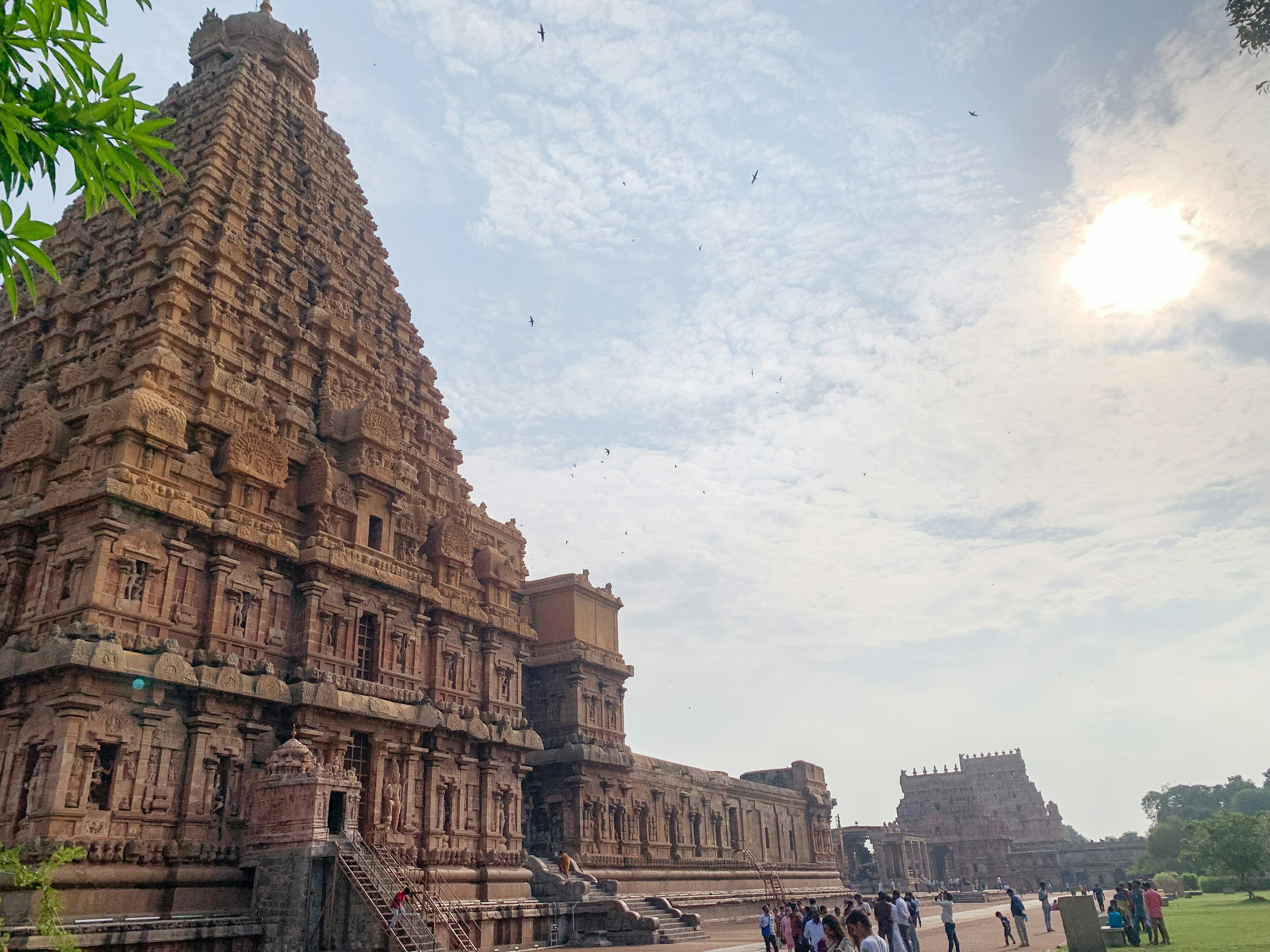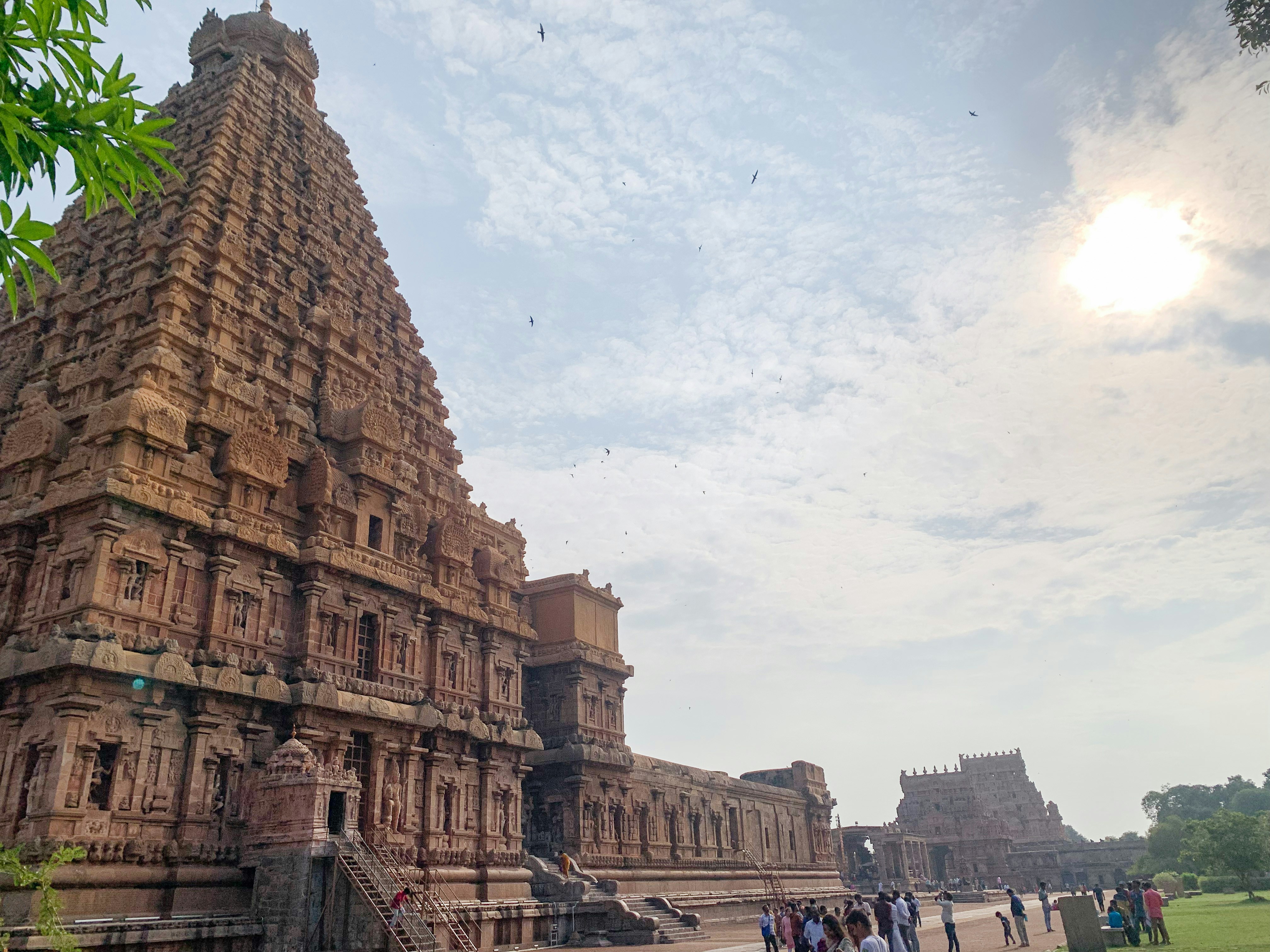Welcome to the magnificent Brihadeeswarar Temple, a symbol of Chola grandeur and architectural brilliance. Located in Thanjavur, Tamil Nadu, this temple stands as a testament to the rich cultural heritage and artistic prowess of the Chola dynasty. Let us take a journey back in time and explore the awe-inspiring beauty and historical significance of this iconic temple.
The Brihadeeswarar Temple, also known as the Peruvudaiyar Kovil, was built by the great Chola emperor, Raja Raja Chola I, in the 11th century. It is dedicated to Lord Shiva and is considered one of the largest and tallest temples in India. The temple complex spreads over an area of more than 25 acres and is surrounded by a massive fortified wall.
As you enter the temple premises, you are greeted by the majestic Rajagopuram, a towering gateway that stands at a height of 216 feet. The intricate carvings and sculptures adorning the gopuram depict various mythological stories and scenes from Hindu epics. It is a visual spectacle that leaves visitors in awe of the craftsmanship and attention to detail.
Walking through the temple corridors, you can’t help but marvel at the architectural brilliance that is on display. The main shrine, dedicated to Lord Shiva, is a masterpiece of Dravidian architecture. The vimana, or the tower above the sanctum sanctorum, soars to a height of 216 feet and is adorned with exquisite sculptures and intricate carvings.
One of the most iconic features of the Brihadeeswarar Temple is the massive Nandi statue, which is carved out of a single stone and measures about 16 feet in height. This majestic bull, known as Nandi, is considered the mount of Lord Shiva and is a symbol of strength and devotion. The sheer size and craftsmanship of this sculpture leave visitors spellbound.
Another highlight of the temple is the sprawling courtyard, known as the Periya Kovil. This open space is surrounded by pillared corridors and houses several smaller shrines dedicated to various deities. The intricate carvings on the pillars and the walls depict scenes from Hindu mythology and showcase the artistic prowess of the Chola artisans.
Visiting the Brihadeeswarar Temple is not just a spiritual experience but also a journey into the rich history and culture of the Chola dynasty. The temple has withstood the test of time and continues to be a living testament to the architectural genius of the Cholas. It is a must-visit destination for anyone interested in exploring the glorious past of South India.
The Brihadeeswarar Temple is not only a testament to the architectural brilliance of the Chola dynasty but also holds immense historical and cultural significance. It was not just a place of worship but also served as a hub for intellectual and artistic pursuits. Scholars, poets, and musicians would gather here to exchange ideas, compose poetry, and perform music and dance.
The temple complex itself is a sprawling architectural marvel, consisting of several structures and sculptures that depict various mythological stories and historical events. The main temple tower, or vimana, stands at a staggering height of 216 feet, making it one of the tallest structures of its time. Its pyramid-like shape, adorned with intricate carvings and sculptures, is a sight to behold.
One of the most iconic features of the Brihadeeswarar Temple is the massive Nandi statue, which stands at the entrance of the temple complex. Carved out of a single stone, this monolithic statue is 16 feet long and 13 feet high, making it one of the largest Nandi statues in India. The attention to detail in the sculpture is remarkable, with every muscle and expression beautifully captured.
Inside the temple, visitors are greeted by the sanctum sanctorum, where the main deity, Lord Shiva, resides. The inner walls of the sanctum are adorned with exquisite frescoes and paintings that depict scenes from Hindu mythology. These paintings have managed to withstand the test of time, showcasing the exceptional skill and craftsmanship of the Chola artisans.
As one explores the temple complex further, they come across various mandapams (halls) that were used for different purposes. The Mahamandapam, for example, was used for conducting religious ceremonies and performances, while the Ardhamandapam served as a gathering place for devotees.
Over the centuries, the Brihadeeswarar Temple has undergone several renovations and restorations to preserve its grandeur. However, it has managed to retain its original charm and continues to attract visitors from all over the world. It serves as a reminder of the rich cultural heritage of India and the architectural brilliance of the Chola dynasty.
As you explore further into the Brihadeeswarar Temple, you will come across the expansive pillared halls that surround the main sanctum. These halls are known as mandapams and are a testament to the architectural brilliance of the Chola dynasty. The mandapams are supported by intricately carved pillars, each telling a unique story through its detailed sculptures.
One of the most remarkable mandapams is the Ardha Mandapam, also known as the Raja Gopuram. This mandapam is adorned with intricate carvings of gods, goddesses, and celestial beings. The sheer grandeur of the Ardha Mandapam is awe-inspiring, with its towering pillars and elaborate ceiling designs.
Another notable feature of the Brihadeeswarar Temple is its sprawling courtyard, known as the prakaram. The prakaram is surrounded by a high compound wall that encloses the entire temple complex. As you walk along the prakaram, you will come across smaller shrines dedicated to various deities, each with its own unique architectural style.
One such shrine is the Subrahmanya Shrine, dedicated to Lord Murugan, the son of Lord Shiva. The Subrahmanya Shrine is adorned with intricate carvings of peacocks, symbolizing beauty and grace. The shrine stands as a testament to the artistic prowess of the Chola craftsmen, who were able to bring life to stone through their masterful carvings.
Overall, the Brihadeeswarar Temple is not only a place of worship but also a masterpiece of architecture and art. Its intricate carvings, towering vimana, and serene atmosphere make it a must-visit destination for anyone interested in history, culture, and spirituality.
Cultural Significance
The Brihadeeswarar Temple not only holds immense architectural significance but also plays a vital role in the cultural and religious fabric of Tamil Nadu. It serves as a center for various religious festivals and rituals, attracting devotees from all over the world. The annual festival of Maha Shivaratri is celebrated with great pomp and grandeur, with devotees offering prayers and participating in various religious ceremonies.
Another significant festival celebrated at the temple is the Natyanjali Dance Festival, which showcases the rich tradition of classical dance forms. Dancers from all over the country gather at the temple to pay homage to Lord Shiva through their mesmerizing performances. The temple premises come alive with the rhythmic beats of the music and the graceful movements of the dancers, creating a truly enchanting experience.
Aside from these major festivals, the Brihadeeswarar Temple also hosts a variety of other cultural events throughout the year. These events include music concerts, religious discourses, and workshops on traditional art forms. Such events not only promote the preservation of Tamil Nadu’s cultural heritage but also provide a platform for artists and scholars to showcase their talent and knowledge.
Moreover, the temple’s cultural significance extends beyond its festivals and events. It is a place of pilgrimage for devotees seeking spiritual solace and enlightenment. The temple’s serene ambience and its association with Lord Shiva, the Hindu god of destruction and transformation, make it a popular destination for devotees and spiritual seekers alike.
Furthermore, the Brihadeeswarar Temple has also been recognized as a UNESCO World Heritage Site, adding to its cultural significance. This prestigious designation acknowledges the temple’s outstanding universal value and its contribution to humanity’s shared heritage. It serves as a testament to the temple’s historical, architectural, and cultural importance, ensuring its preservation for future generations to appreciate and admire.
In conclusion, the Brihadeeswarar Temple’s cultural significance cannot be overstated. From its religious festivals and cultural events to its status as a place of pilgrimage and a UNESCO World Heritage Site, the temple continues to be a beacon of spirituality, art, and heritage in Tamil Nadu.
A Timeless Wonder
The Brihadeeswarar Temple stands as a timeless wonder, a testament to the architectural brilliance and cultural heritage of the Chola dynasty. Its grandeur and magnificence continue to captivate visitors from all walks of life, leaving them in awe of the rich history and artistic achievements of ancient India.
As you step into the temple premises, you are immediately transported back in time, enveloped by an atmosphere that resonates with spirituality and devotion. The temple’s towering vimana, or tower, reaches for the heavens, its intricate carvings telling stories of gods and goddesses, mythological tales, and scenes from everyday life during the Chola period.
Every inch of the temple is adorned with exquisite sculptures and reliefs, showcasing the mastery of Chola artisans. The outer walls of the temple are a canvas of stone, depicting celestial beings, musicians, dancers, and deities in various poses. The attention to detail is awe-inspiring, with each figure intricately carved to perfection.
As you make your way through the temple, you will come across the main sanctum, where the grand deity of Lord Shiva, in the form of Brihadeeswarar, resides. The sanctum is a sacred space, filled with the fragrance of incense and the sound of devotional chants. The presence of the deity is palpable, evoking a sense of peace and tranquility in all who enter.
Outside the main sanctum, you will find smaller shrines dedicated to other deities, each with its own unique charm and significance. These shrines are adorned with colorful flowers, vibrant silk fabrics, and offerings from devotees, creating a vibrant and lively atmosphere.
Visiting the Brihadeeswarar Temple is not just a journey through history, but also a spiritual experience. The temple’s architecture and design are not mere aesthetic marvels but are deeply rooted in Hindu philosophy and symbolism. The vimana represents Mount Meru, the mythical abode of the gods, while the intricate carvings depict stories from Hindu mythology, teaching valuable lessons and imparting spiritual knowledge to all who observe them.
So, if you ever find yourself in Tamil Nadu, make sure to visit the Brihadeeswarar Temple and witness the grandeur of the Chola dynasty firsthand. Prepare to be mesmerized by the intricate carvings, towering vimana, and the spiritual aura that surrounds this architectural marvel. Allow yourself to be transported to a different era, where art, spirituality, and devotion intertwine to create an experience that is truly unforgettable.
Enter your email to get the Latest Updated Exploring News and Topics
Discover more from atozexplore.com
Subscribe to get the latest posts sent to your email.







